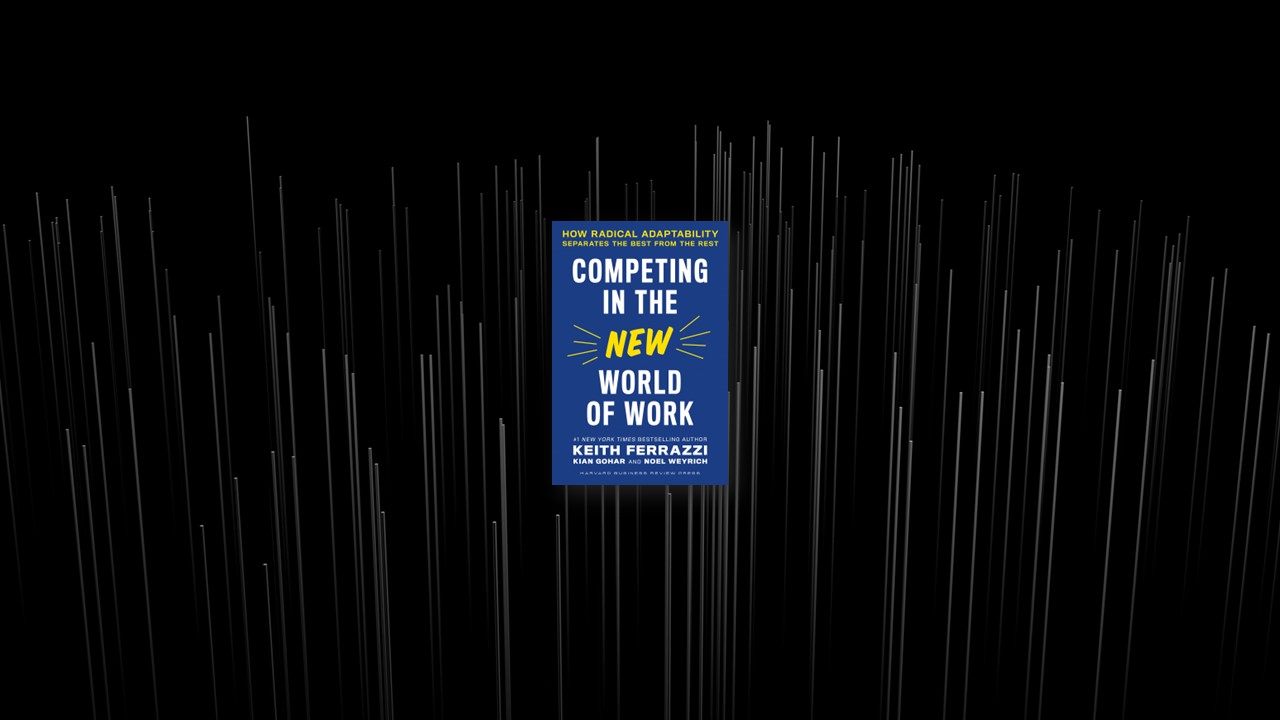Radical Adaptability
When leaders were compelled to set aside red tape and delegate more decision-making, results flowed faster than ever before. Companies responded by collaborating more intensively and communicating more thoroughly. Team members were more candid with each other and spoke more freely and directly because the emergency eliminated opportunities for conflict avoidance and passive-aggressive communication. Team members also became more generous. They broke out of siloed that’s-not-my-job behaviors.
All around the world, big companies and small businesses alike were forced to discover new processes, new markets, and new business models that proved to be lasting sources of competitive advantage. London’s top Michelin-star restaurants got into the business of home deliveries and cook-it-yourself meal kits.
Stagekings, an Australian theater set-building company, pivoted to making home office desks under the brand name IsoKing—and looked to expand to Europe.
Spice seller Diaspora Co., with its suppliers in India locked down, switched to taking preorders as a cash-flow strategy and saw sales surge 35 percent.
Even in a radically disrupted business environment, companies learned they could thrive if they could crack the code of radical adaptability and master its lessons.
The pandemic revealed in ways big and small much of what hadn’t been working with work for a long time: top-down, overplanned, draining, reactive, bureaucratic, static, and narrowly mission oriented. Now we’ve all been invited to join a new world of work that has been emerging for many years, one that’s collaborative and inclusive, agile, resilient, anticipatory, reinventive, flexible, and purpose-driven.
New ways of thinking don’t come easy. Sometimes it takes immersion in a new, strange world to recognize that the familiar world has not been serving you very well.
Collaborate through Inclusion
The pandemic forced a sudden revolution in collaboration at most organizations. The necessity to begin operating through remote work exposed a rising awareness of what has always been true: collaboration has nothing to do with where employees show up for work; it has everything to do with how they show up. Outcomes have always mattered more than presentee-ism, even if performance hasn’t always been measured or rewarded that way.
As companies began reconsidering their policies toward remote work, there was a great deal of wrongheadedness in the debate. Many leaders continued to insist that physically proximate work is inherently the best form of collaboration, citing examples of teams that had lost productivity by doing remote work poorly. The trouble is that so many made the move to remote on a strict survival basis that they neglected to take full advantage of the opportunities remote work afforded. Relatively few organizations achieved higher levels of productivity by truly optimizing their remote work practices for greater collaboration and much wider inclusion.
Do we come together as a team with a shared commitment to radical collaboration, and not only in times of crisis?
The most successful companies ignore organizational structures to ensure that everyone on the team crosses the finish line together. By recontracting with a commitment to co-elevation and employing a set of high-return practices that foster inclusion and collaboration, we can uncover unexpected revenue and risk-mitigation opportunities.
Do we harness innovation and collaboration beyond our team and from all corners of our organization?
We have known about the wisdom of crowds for centuries. With the widespread use of communication and collaboration technologies, radically inclusive companies systematically cast a wide net across the organization and, in doing so, generate a broader set of innovative ideas and collaboration opportunities.
Do we leverage a broader external ecosystem of customers, vendors, and partners to drive higher levels of collaboration?
With the pandemic, we found ourselves in the trenches together, facing common challenges. As a result, what were once transactional relationships suddenly became deeper and more empathy driven. Radically inclusive companies deepen external partnerships and find opportunities to co-elevate with customers, vendors, and partners—and even competitors.
Lead through Enterprise Agile
The pandemic made the shift toward agile a necessity, not a choice. Delta Air Lines, for instance, had an urgent need to keep its passengers safe by sanitizing its fleet after each flight. The objective was clear and the customer benefit was obvious, but there was no time to devise a solution through normal hierarchical channels. Instead, the decision-making and problem-solving had to be pushed down to the people closest to the work itself—a critical agile principle. And under those conditions, agile practices (whether or not they were recognized as such) like self-organization, daily stand-up meetings, and weekly sprints proved to be lifelines. By its nature, agile invites breakthrough innovation, because agile presses every team member to keep asking, who else do we need on this team? How can we create more value? How can this project be better?
Do our operational teams have the autonomy to experiment their way to fast, breakthrough innovation?
Agile teams allow radically adaptable companies to move much faster to deliver value to end customers when they are not constrained by traditional top-down planning and strategy frameworks. Discrete work sprints, real-time feedback from customers, and frequent and focused stand-up meetings all come together within agile to increase the likelihood that projects reach their full potential and happen within a timeframe that meets the ever-changing demands of the market.
Are our team innovation projects overly vague and ambitious, or do we break down our initiatives into bite-size milestones that can be achieved, celebrated, and built on?
Radically adaptable companies often run multiple, or even dozens of, agile teams that make continuous progress toward meaningful goals. At the end of each biweekly sprint, the output is bulletproofed for quality by the team and external stakeholders, who also agree on the scope of the next sprint and whether a course correction is necessary to achieve the project brief.
Promote Team Resilience
In October 2020, when Apple CEO Tim Cook shared his outlook on the company’s fourth quarter with Wall Street analysts, he gave major credit to team resilience for the way Apple’s financial performance had exceeded expectations.
“Even though we’re apart, it’s been obvious this year that around the company, teams and colleagues have been leaning on and counting on each other more than in normal times,” he said. “I think that instinct, that resilience has been an essential part of how we have navigated this year.”
Psychologists who have studied resilience define it typically as “the process of adapting well in the face of adversity, trauma, tragedy [and threats].
Each individual’s capacity for personal resilience is highly dependent on the person’s mental and emotional makeup.
Teams succeed or fail together, and through our own behavior, we can either enhance or diminish our teammates’ resilience.
Radically adaptable companies monitor and maintain high resilience much like a critical battery that needs to stay charged, whether in times of crisis or not. Our leaders invest in the physical and emotional well-being of employees and work to ensure that interpersonal dynamics do not erode team energy levels. Our leaders are vulnerable enough to articulate their own fears and anxieties and can model resilience through their own work habits.
Do we proactively diagnose specific stressors that erode resilience?
Radically adaptable companies use surveys, regular check-ins, and performance assessments to diagnose issues and implement initiatives to keep the team’s battery charged. High-return practices like candor breaks and energy-level check-ins are effective at diagnosing overall team resilience.
Do we co-elevate as a team to ensure that we own each other’s mental and physical well-being?
The best performing team members own each other’s successes, which is a core premise of co-elevation. Shared accountability for every team member’s resilience is prioritized.
Future-Proof Your Business Model
As you consider your role as a radically adaptable leader, it’s time to pause and ask yourself, “What business are we really in?” Consider approaching this question from a first principles perspective, and question your major assumptions about your business and your industry. Think of yourself as a toddler, consistently questioning every new experience. “But why?” It’s possibly the most annoying repeated phrase that parents must respond to, but a child’s healthy development depends on the child’s constant questioning of its perceptions of the world. The same can be said about you and your business.
It has been more than sixty years since marketing guru Theodore Levitt pointed out in Harvard Business Review that railroad companies were failing because they had failed their customers. Gorged on profits from their monopoly routes, the railroad barons assumed they were in the railroad business and saw the rise of other forms of transportation only as competition. Had the railroads instead understood their role as transportation service providers, they could have used their enormous profits to invest in cars, trucks, airlines, and related industries that reflected the evolving preferences of their customers. Instead, the railroad barons gradually lost their customers and then, one by one, their companies.
Does our company actively envision what our industry will look like in a decade?
Radically adaptable companies actively engage the collective brain trust of their senior leaders, board members, advisers, and staff members to zoom out using foresight tools and imagine the industry landscape a decade out.
How does our company incorporate frontier technologies?
Do we take consistent, strategic, and potentially high-impact short-term zoom-in bets using new technologies to move the company toward our long-term zoom-out vision? These bets are structured as short-horizon, experimental projects that are free from traditional bureaucracy and often challenge the status quo thinking in the company.
How do we build community around every aspect of our company?
Decentralized systems are changing the dynamics of power within industries, so the most radically adaptable companies leverage communities of consumers and fans to build moats around existing business models to withstand future uncertainty and commodification.


